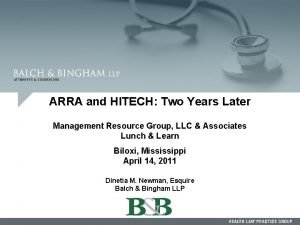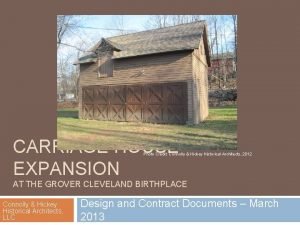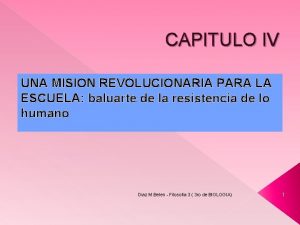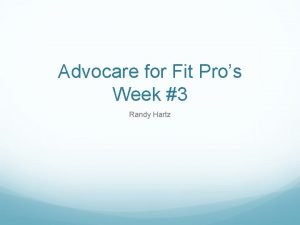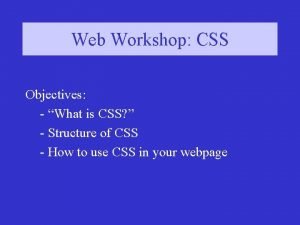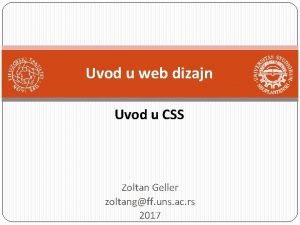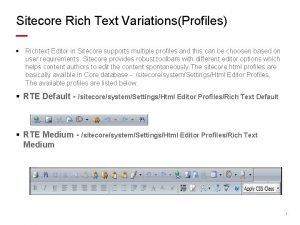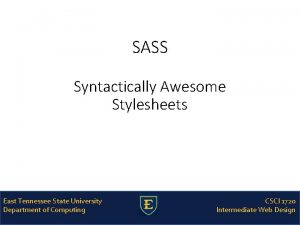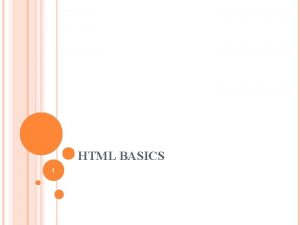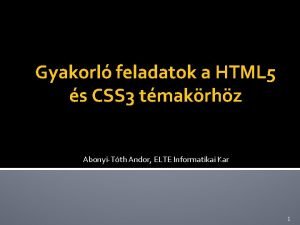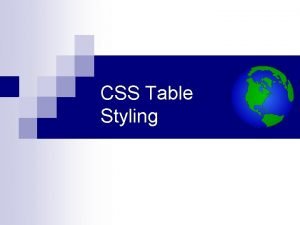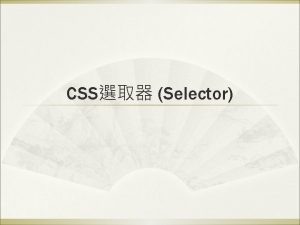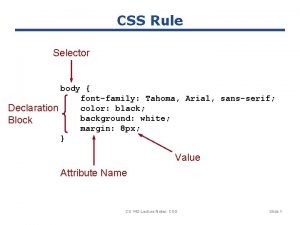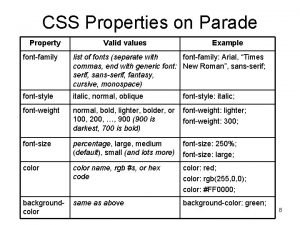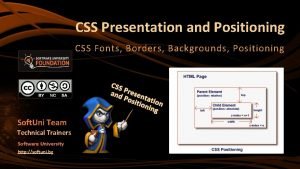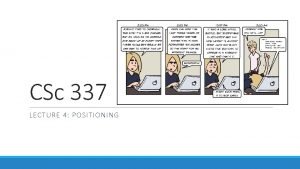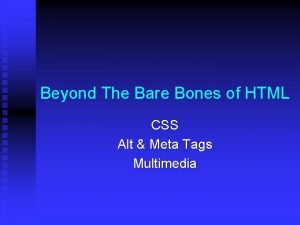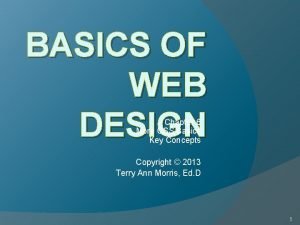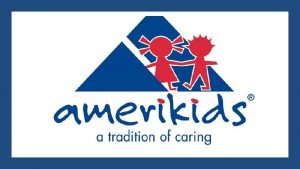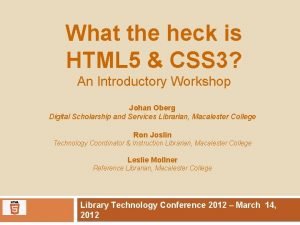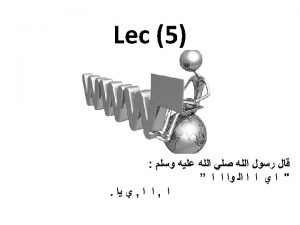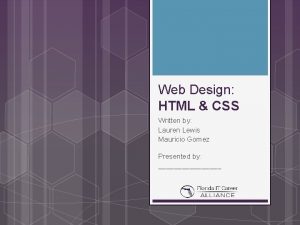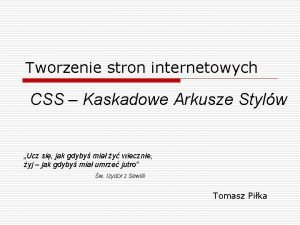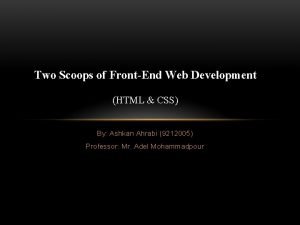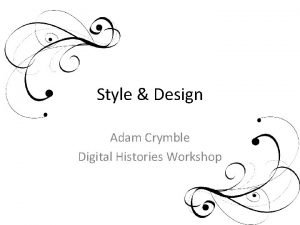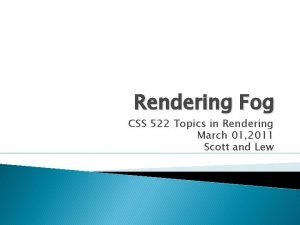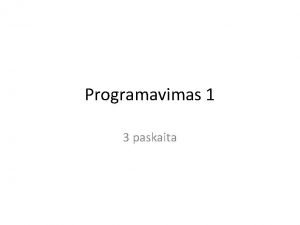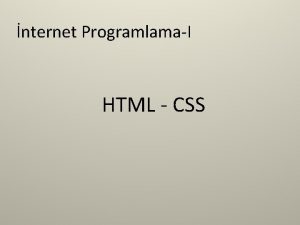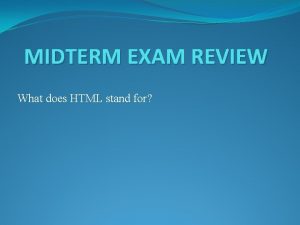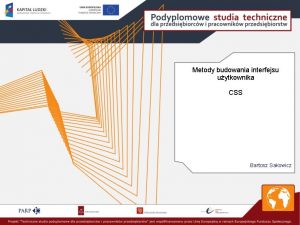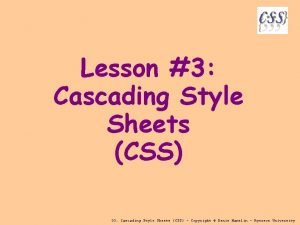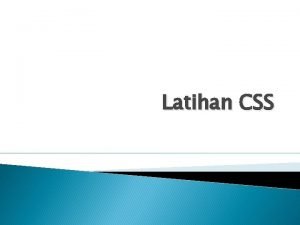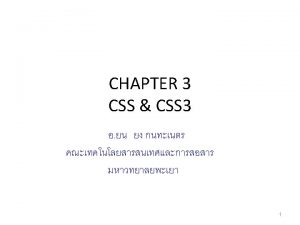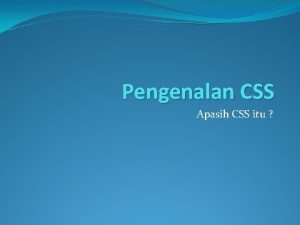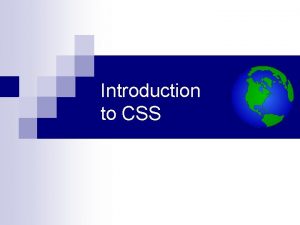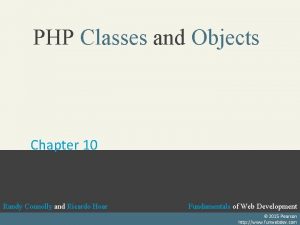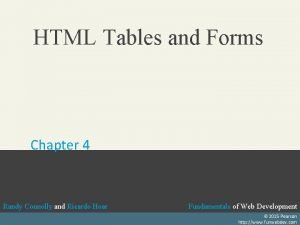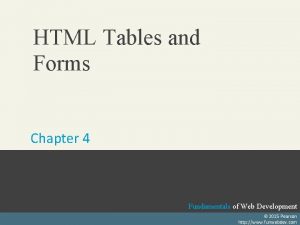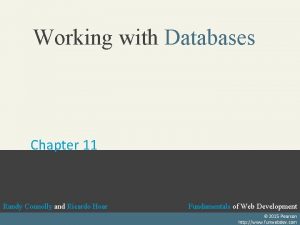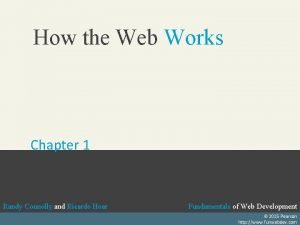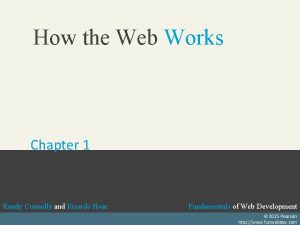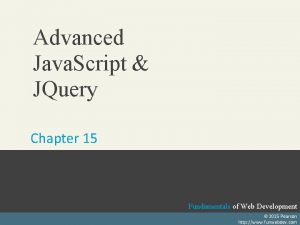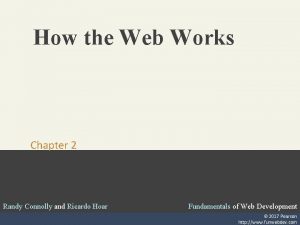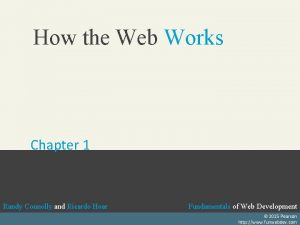CSS 1 Introduction Chapter 3 Randy Connolly and






































![Attribute Selectors <head lang="en"> <meta charset="utf-8"> <title>Share Your Travels</title> <style> [title] { cursor: help; Attribute Selectors <head lang="en"> <meta charset="utf-8"> <title>Share Your Travels</title> <style> [title] { cursor: help;](https://slidetodoc.com/presentation_image_h2/5dd4759ebfab1c8d1acbf5d4b1f578eb/image-39.jpg)































































- Slides: 102

CSS 1: Introduction Chapter 3 Randy Connolly and Ricardo Hoar Fundamentals of Web Development Textbook to be published by Pearson © Ed 2015 in early Pearson 2014 Fundamentals ofhttp: //www. funwebdev. com Web Development

Objectives 2 CSS Syntax 1 3 Location of Styles 4 Selectors 5 The Cascade: How Styles Interact 6 The Box Model 7 CSS Text Styling What is CSS? Fundamentals of Web Development

Section 1 of 7 WHAT IS CSS? Fundamentals of Web Development

What is CSS? You be styling soon CSS is a W 3 C standard for describing the presentation (or appearance) of HTML elements. With CSS, we can assign • font properties, • colors, • sizes, • borders, • background images, • even the position of elements. Fundamentals of Web Development

What is CSS? You be styling soon CSS is a language in that it has its own syntax rules. CSS can be added directly to any HTML element (via the style attribute), within the <head> element, or, most commonly, in a separate text file that contains only CSS. Fundamentals of Web Development

Benefits of CSS Why using CSS is a better way of describing presentation than HTML • The degree of formatting control in CSS is significantly better than that provided in HTML. • Web sites become significantly more maintainable because all formatting can be centralized into one, or a small handful, of CSS files. • CSS-driven sites are more accessible. • A site built using a centralized set of CSS files for all presentation will also be quicker to download because each individual HTML file will contain less markup. • CSS can be used to adopt a page for different output mediums. Fundamentals of Web Development

CSS Versions Let’s just say there’s more than 1 • W 3 C published the CSS Level 1 Recommendation in 1996. • A year later, the CSS Level 2 Recommendation (also more succinctly labeled simply as CSS 2) was published. • Even though work began over a decade ago, an updated version of the Level 2 Recommendation, CSS 2. 1, did not become an official W 3 C Recommendation until June 2011. • And to complicate matters even more, all through the last decade (and to the present day as well), during the same time the CSS 2. 1 standard was being worked on, a different group at the W 3 C was working on a CSS 3 draft. Fundamentals of Web Development

Browser Adoption Insert obligatory snide comment about Internet Explorer 6 here While Microsoft’s Internet Explorer was an early champion of CSS, its later versions (especially IE 5, IE 6, and IE 7) for Windows had uneven support for certain parts of CSS 2. In fact, all browsers have left certain parts of the CSS 2 Recommendation unimplemented. CSS has a reputation for being a somewhat frustrating language. • this reputation is well deserved! Fundamentals of Web Development

Section 2 of 7 CSS SYNTAX Fundamentals of Web Development

CSS Syntax Rules, properties, values, declarations A CSS document consists of one or more style rules. A rule consists of a selector that identifies the HTML element or elements that will be affected, followed by a series of property and value pairs (each pair is also called a declaration). Fundamentals of Web Development

Declaration Blocks The series of declarations is also called the declaration block. • A declaration block can be together on a single line, or spread across multiple lines. • The browser ignores white space • Each declaration is terminated with a semicolon. Fundamentals of Web Development

Selectors Which elements Every CSS rule begins with a selector. The selector identifies which element or elements in the HTML document will be affected by the declarations in the rule. Another way of thinking of selectors is that they are a pattern which is used by the browser to select the HTML elements that will receive the style. Fundamentals of Web Development

Properties Which style properties of the selected elements Each individual CSS declaration must contain a property. These property names are predefined by the CSS standard. The CSS 2. 1 Recommendation defines over a hundred different property names. Fundamentals of Web Development

Properties Common CSS properties Property Type Property Fonts font-family font-size font-style font-weight @font-face letter-spacing line-height text-align text-decoration text-indent background-color background-image background-position background-repeat color border-color border-width border-style border-top-color border-top-width etc Text Color and background Borders Fundamentals of Web Development

Properties Common CSS properties continued. Property Type Property Spacing padding-bottom, padding-left, padding-right, padding-top margin-bottom, margin-left, margin-right, margin-top height max-width min-height min-width bottom, left, right, top clear display float overflow position visibility z-index list-style-image list-style-type Sizing Layout Lists Fundamentals of Web Development

Values What style value for the properties Each CSS declaration also contains a value for a property. • The unit of any given value is dependent upon the property. • Some property values are from a predefined list of keywords. • Others are values such as length measurements, percentages, numbers without units, color values, and URLs. Fundamentals of Web Development

Color Values CSS supports a variety of different ways of describing color Method Name RGB Hexadecimal RGBa HSL Description Use one of 17 standard color names. CSS 3 has 140 standard names. Uses three different numbers between 0 and 255 to describe the Red, Green, and Blue values for the color. Uses a six-digit hexadecimal number to describe the red, green, and blue value of the color; each of the three RGB values is between 0 and FF (which is 255 in decimal). Notice that the hexadecimal number is preceded by a hash or pound symbol (#). Allows you to add an alpha, or transparency, value. This allows a background color or image to “show through” the color. Transparency is a value between 0. 0 (fully transparent) and 1. 0 (fully opaque). Allows you to specify a color using Hue Saturation and Light values. This is available only in CSS 3. HSLA is also available as well. Example color: red; color: hotpink; /* CSS 3 only */ color: rgb(255, 0, 0); color: rgb(255, 105, 180); color: #FF 0000; color: #FF 69 B 4; color: rgb(255, 0, 0, 0. 5); color: hsl(0, 100%); color: hsl(330, 59%, 100%); Fundamentals of Web Development

Units of Measurement There are multiple ways of specifying a unit of measurement in CSS Some of these are relative units, in that they are based on the value of something else, such as the size of a parent element. Others are absolute units, in that they have a realworld size. Unless you are defining a style sheet for printing, it is recommended to avoid using absolute units. Pixels are perhaps the one popular exception (though as we shall see later there also good reasons for avoiding the pixel unit). Fundamentals of Web Development

Relative Units Unit Description Type px Pixel. In CSS 2 this is a relative measure, while in CSS 3 it is absolute (1/96 of an inch). Relative (CSS 2) Absolute (CSS 3) em Equal to the computed value of the font-size property of Relative the element on which it is used. When used for font sizes, the em unit is in relation to the font size of the parent. % A measure that is always relative to another value. The precise meaning of % varies depending upon which property it is being used. Relative ex A rarely used relative measure that expresses size in relation to the x-height of an element’s font. Another rarely used relative measure; this one expresses size in relation to the width of the zero ("0") character of an element’s font. Relative Stands for root em, which is the font size of the root element. Unlike em, which may be different for each element, the rem is constant throughout the document. Relative Stands for viewport width and viewport height. Both are percentage values (between 0 and 100) of the viewport (browser window). This allows an item to change size when the viewport is resized. Relative ch rem vw, vh Relative (CSS 3 only) Fundamentals of Web Development

Absolute Units Unit Description Type in Inches Absolute cm Centimeters Absolute mm Millimeters Absolute pt Points (equal to 1/72 of an inch) Absolute pc Pica (equal to 1/6 of an inch) Absolute Fundamentals of Web Development

Comments in CSS It is often helpful to add comments to your style sheets. Comments take the form: /* comment goes here */ Fundamentals of Web Development

Section 3 of 7 LOCATION OF STYLES Fundamentals of Web Development

Actually there are three … Different types of style sheet Author-created style sheets (what we are learning in this presentation). User style sheets allow the individual user to tell the browser to display pages using that individual’s own custom style sheet. This option is available in a browser usually in its accessibility options area. The browser style sheet defines the default styles the browser uses for each HTML element. Fundamentals of Web Development

Style Locations Author Created CSS style rules can be located in three different locations. • Inline • Embedded • External You can combine all 3! Fundamentals of Web Development

Inline Styles Style rules placed within an HTML element via the style attribute An inline style only affects the element it is defined within and will override any other style definitions for the properties used in the inline style. Using inline styles is generally discouraged since they increase bandwidth and decrease maintainability. Inline styles can however be handy for quickly testing out a style change. Fundamentals of Web Development

Embedded Style Sheet Style rules placed within the <style> element inside the <head> element While better than inline styles, using embedded styles is also by and large discouraged. Since each HTML document has its own <style> element, it is more difficult to consistently style multiple documents when using embedded styles. Fundamentals of Web Development

External Style Sheet Style rules placed within a external text file with the. css extension This is by far the most common place to locate style rules because it provides the best maintainability. • When you make a change to an external style sheet, all HTML documents that reference that style sheet will automatically use the updated version. • The browser is able to cache the external style sheet which can improve the performance of the site Fundamentals of Web Development

Section 4 of 7 SELECTORS Fundamentals of Web Development

Selectors Things that make your life easier When defining CSS rules, you will need to first need to use a selector to tell the browser which elements will be affected. CSS selectors allow you to select • individual elemenets • multiple HTML elements, • elements that belong together in some way, or • elements that are positioned in specific ways in the document hierarchy. There a number of different selector types. Fundamentals of Web Development

Element Selectors Selects all instances of a given HTML element Uses the HTML element name. You can select all elements by using the universal element selector, which is the * (asterisk) character. Fundamentals of Web Development

Grouped Selectors Selecting multiple things You can select a group of elements by separating the different element names with commas. This is a sensible way to reduce the size and complexity of your CSS files, by combining multiple identical rules into a single rule. Fundamentals of Web Development

Reset Grouped selectors are often used as a way to quickly reset or remove browser defaults. The goal of doing so is to reduce browser inconsistencies with things such as margins, line heights, and font sizes. These reset styles can be placed in their own css file (perhaps called reset. css) and linked to the page before any other external styles sheets. Fundamentals of Web Development

Class Selectors Simultaneously target different HTML elements A class selector allows you to simultaneously target different HTML elements regardless of their position in the document tree. If a series of HTML element have been labeled with the same class attribute value, then you can target them for styling by using a class selector, which takes the form: period (. ) followed by the class name. Fundamentals of Web Development

Class Selectors <head> <title>Share Your Travels </title> <style>. first { font-style: italic; color: brown; } </style> </head> <body> <h 1 class="first">Reviews</h 1> <div> <p class="first">By Ricardo on <time>September 15, 2012</time></p> <p>Easy on the HDR buddy. </p> </div> <hr/> <div> <p class="first">By Susan on <time>October 1, 2012</time></p> <p>I love Central Park. </p> </div> <hr/> </body> Fundamentals of Web Development

Id Selectors Target a specific element by its id attribute An id selector allows you to target a specific element by its id attribute regardless of its type or position. If an HTML element has been labeled with an id attribute, then you can target it for styling by using an id selector, which takes the form: pound/hash (#) followed by the id name. Note: You should only be using an id once per page Fundamentals of Web Development

Id Selectors <head lang="en"> <meta charset="utf-8"> <title>Share Your Travels -- New York - Central Park</title> <style> #latest. Comment { font-style: italic; color: brown; } </style> </head> <body> <h 1>Reviews</h 1> <div id="latest. Comment"> <p>By Ricardo on <time>September 15, 2012</time></p> <p>Easy on the HDR buddy. </p> </div> <hr/> <div> <p>By Susan on <time>October 1, 2012</time></p> <p>I love Central Park. </p> </div> <hr/> </body> Fundamentals of Web Development

Id versus Class Selectors How to decide Id selectors should only be used when referencing a single HTML element since an id attribute can only be assigned to a single HTML element. Class selectors should be used when (potentially) referencing several related elements. Fundamentals of Web Development

Attribute Selectors Selecting via presence of element attribute or by the value of an attribute An attribute selector provides a way to select HTML elements by either the presence of an element attribute or by the value of an attribute. This can be a very powerful technique, but because of uneven support by some of the browsers, not all web authors have used them. Attribute selectors can be a very helpful technique in the styling of hyperlinks and images. Fundamentals of Web Development
![Attribute Selectors head langen meta charsetutf8 titleShare Your Travelstitle style title cursor help Attribute Selectors <head lang="en"> <meta charset="utf-8"> <title>Share Your Travels</title> <style> [title] { cursor: help;](https://slidetodoc.com/presentation_image_h2/5dd4759ebfab1c8d1acbf5d4b1f578eb/image-39.jpg)
Attribute Selectors <head lang="en"> <meta charset="utf-8"> <title>Share Your Travels</title> <style> [title] { cursor: help; padding-bottom: 3 px; border-bottom: 2 px dotted blue; text-decoration: none; } </style> </head> <body> <div> <img src="images/flags/CA. png" title="Canada Flag" /> <h 2><a href="countries. php? id=CA" title="see posts from Canada"> Canada</a> </h 2> <p>Canada is a North American country consisting of … </p> <div> <img src="images/square/6114907897. jpg" title="At top of Sulpher Mountain" > <img src="images/square/6592317633. jpg" title="Grace Presbyterian Church" > <img src="images/square/6592914823. jpg" title="Calgary Downtown" > </div> </body> Fundamentals of Web Development

Attribute Selectors Fundamentals of Web Development

Pseudo Selectors Select something that does not exist explicitly as an element A pseudo-element selector is a way to select something that does not exist explicitly as an element in the HTML document tree but which is still a recognizable selectable object. A pseudo-class selector does apply to an HTML element, but targets either a particular state or, in CSS 3, a variety of family relationships. The most common use of this type of selectors is for targeting link states. Fundamentals of Web Development

Pseudo Selectors Fundamentals of Web Development

Contextual Selectors Select elements based on their ancestors, descendants, or siblings A contextual selector (in CSS 3 also called combinators) allows you to select elements based on their ancestors, descendants, or siblings. That is, it selects elements based on their context or their relation to other elements in the document tree. Fundamentals of Web Development

Contextual Selectors Selector Matches Example Descendant A specified element that is contained somewhere within another specified element div p A specified element that is a direct child of the specified element div>h 2 Child Selects a <p> element that is contained somewhere within a <div> element. That is, the <p> can be any descendant, not just a child. Selects an <h 2> element that is a child of a <div> element. Adjacent Sibling A specified element that is the next h 3+p sibling (i. e. , comes directly after) of the Selects the first <p> after any <h 3>. specified element. General Sibling A specified element that shares the same parent as the specified element. h 3~p Selects all the <p> elements that share the same parent as the <h 3>. Fundamentals of Web Development

Descendant Selector Selects all elements that are contained within another element While some of these contextual selectors are used relatively infrequently, almost all web authors find themselves using descendant selectors. A descendant selector matches all elements that are contained within another element. The character used to indicate descendant selection is the space character. Fundamentals of Web Development

Contextual Selectors in Action Fundamentals of Web Development

Section 5 of 7 THE CASCADE: HOW STYLES INTERACT Fundamentals of Web Development

Why Conflict Happens In CSS that is Because • there are three different types of style sheets (author-created, user-defined, and the default browser style sheet), • author-created stylesheets can define multiple rules for the same HTML element, CSS has a system to help the browser determine how to display elements when different style rules conflict. Fundamentals of Web Development

Cascade How conflicting rules are handled in CSS The “Cascade” in CSS refers to how conflicting rules are handled. The visual metaphor behind the term cascade is that of a mountain stream progressing downstream over rocks. The downward movement of water down a cascade is meant to be analogous to how a given style rule will continue to take precedence with child elements. Fundamentals of Web Development

Cascade Principles CSS uses the following cascade principles to help it deal with conflicts: • inheritance, • specificity, • location Fundamentals of Web Development

Inheritance Cascade Principle #1 Many (but not all) CSS properties affect not only themselves but their descendants as well. Font, color, list, and text properties are inheritable. Layout, sizing, border, background and spacing properties are not. Fundamentals of Web Development

Inheritance Fundamentals of Web Development

Inheritance How to force inheritance It is possible to tell elements to inherit properties that are normally not inheritable. Fundamentals of Web Development

Inheritance Fundamentals of Web Development

Specificity Cascade Principle #2 Specificity is how the browser determines which style rule takes precedence when more than one style rule could be applied to the same element. The more specific the selector, the more it takes precedence (i. e. , overrides the previous definition). Fundamentals of Web Development

Specificity How it works The way that specificity works in the browser is that the browser assigns a weight to each style rule. When several rules apply, the one with the greatest weight takes precedence. Fundamentals of Web Development

Specificity These color and font-weight properties are inheritable and thus potentially applicable to all the child elements contained within the body. However, because the <div> and <p> elements also have the same properties set, they override the value defined for the <body> element because their selectors (div and p) are more specific. Class selectors are more specific than element selectors, and thus take precedence and override element selectors. Id selectors are more specific than class selectors, and thus take precedence and override class selectors. Fundamentals of Web Development

Specificity Algorithm The algorithm that is used to determine specificity is : First count 1 if the declaration is from a 'style' attribute in the HTML, 0 otherwise (let that value = a). Count the number of ID attributes in the selector (let that value = b). Count the number of other attributes and pseudoclasses in the selector (let that value = c). Count the number of element names and pseudoelements in the selector (let that value = d). Finally, concatenate the four numbers a+b+c+d together to calculate the selector’s specificity. Fundamentals of Web Development

Specificity Algorithm Fundamentals of Web Development

Location Cascade Principle #3 When inheritance and specificity cannot determine style precedence, the principle of location will be used. The principle of location is that when rules have the same specificity, then the latest are given more weight. Fundamentals of Web Development

Location Can you guess what will be the color of the sample text ? Fundamentals of Web Development

Location What color would the sample text be if there wasn’t an inline style definition? Fundamentals of Web Development

Location There’s always an exception There is one exception to the principle of location. If a property is marked with !important in an authorcreated style rule, then it will override any other author-created style regardless of its location. The only exception is a style marked with !important in an user style sheet; such a rule will override all others. Fundamentals of Web Development

Section 6 of 7 THE BOX MODEL Fundamentals of Web Development

The Box Model Time to think inside the box In CSS, all HTML elements exist within an element box. It is absolutely essential that you familiarize yourself with the terminology and relationship of the CSS properties within the element box. Fundamentals of Web Development

The Box Model Fundamentals of Web Development

Background Box Model Property #1 The background color or image of an element fills an element out to its border (if it has one that is). In contemporary web design, it has become extremely common too use CSS to display purely presentational images (such as background gradients and patterns, decorative images, etc) rather than using the <img> element. Fundamentals of Web Development

Background Properties Property Description background A combined short-hand property that allows you to set the background values in one property. While you can omit properties with the short-hand, do remember that any omitted properties will be set to their default value. background-attachment Specifies whether the background image scrolls with the document (default) or remains fixed. Possible values are: fixed, scroll. background-color Sets the background color of the element. background-image Specifies the background image (which is generally a jpeg, gif, or png file) for the element. Note that the URL is relative to the CSS file and not the HTML. CSS 3 introduced the ability to specify multiple background images. background-position Specifies where on the element the background image will be placed. Some possible values include: bottom, center, left, and right. You can also supply a pixel or percentage numeric position value as well. When supplying a numeric value, you must supply a horizontal/vertical pair; this value indicates its distance from the top left corner of the element. background-repeat Determines whether the background image will be repeated. This is a common technique for creating a tiled background (it is in fact the default behavior). Possible values are: repeat, repeat-x, repeat-y, and no-repeat. background-size New to CSS 3, this property lets you modify the size of the background image. Fundamentals of Web Development

Background Repeat Fundamentals of Web Development

Background Position Fundamentals of Web Development

Borders Box Model Property #2 Borders provide a way to visually separate elements. You can put borders around all four sides of an element, or just one, two, or three of the sides. Fundamentals of Web Development

Borders Property Description border A combined short-hand property that allows you to set the style, width, and color of a border in one property. The order is important and must be: border-style border-width border-color border-style Specifies the line type of the border. Possible values are: solid, dotted, dashed, double, groove, ridge, inset, and outset. border-width The width of the border in a unit (but not percents). A variety of keywords (thin, medium, etc) are also supported. border-color The color of the border in a color unit. The radius of a rounded corner. The URL of an image to use as a border-radius border-image Fundamentals of Web Development

Shortcut notation TRBL With border, margin, and padding properties, there are long-form and shortcut methods to set the 4 sides border-top-color: red; border-right-color: green; border-bottom-color: yellow; border-left-color: blue; /* /* border-color: red; /* sets all four sides to red */ border-color: red green orange blue; sets just the the top side */ right side */ bottom side */ left side */ /* sets all four sides differently */ When using this multiple values shortcut, they are applied in clockwise order starting at the top. Thus the order is: top right bottom left. Fundamentals of Web Development

Margins and Padding Box Model Properties #3 and #4 Fundamentals of Web Development

Margins Why they will cause you trouble. Did you notice that the space between paragraphs one and two and between two and three is the same as the space before paragraph one and after paragraph three? This is due to the fact that adjoining vertical margins collapse. Fundamentals of Web Development

Collapsing Margins If overlapping margins did not collapse, then margin space for would be 180 p (90 pixels for the bottom margin of the first <div> + 90 pixels for the top margin of the second <div>), while the margins and for would be 100 px. However, as you can see this is not the case. Fundamentals of Web Development

Collapsing Margins How it works When the vertical margins of two elements touch, • the largest margin value of the elements will be displayed • the smaller margin value will be collapsed to zero. Horizontal margins, on the other hand, never collapse. To complicate matters even further, there a large number of special cases in which adjoining vertical margins do not collapse. Fundamentals of Web Development

Width and Height Box Model Properties #5 and #6 The width and height properties specify the size of the element’s content area. Perhaps the only rival for collapsing margins in troubling our students, box dimensions have a number of potential issues. Fundamentals of Web Development

Width and Height Potential Problem #1 Only block-level elements and non-text inline elements such as images have a width and height that you can specify. By default the width of and height of elements is the actual size of the content. For text, • this is determined by the font size and font face; For images, • the width and height of the actual image in pixels determines the element box’s dimensions. Fundamentals of Web Development

Width and Height Potential Problem #2 Since the width and the height refer to the size of the content area, by default, the total size of an element is equal to not only its content area, but also to the sum of its padding, borders, and margins. Fundamentals of Web Development

Default Fundamentals of Web Development

Width and Height Fundamentals of Web Development

Overflow Property Fundamentals of Web Development

Sizing Elements Time to embrace ems and percentages While the previous examples used pixels for its measurement, many contemporary designers prefer to use percentages or em units for widths and heights. • When you use percentages, the size is relative to the size of the parent element. • When you use ems, the size of the box is relative to the size of the text within it. The rationale behind using these relative measures is to make one’s design scalable to the size of the browser or device that is viewing it. Fundamentals of Web Development

Fundamentals of Web Development

Developer Tools Help is on the way Developer tools in current browsers make it significantly easier to examine and troubleshot CSS than was the case a decade ago. You can use the various browsers’ CSS inspection tools to examine, for instance, the box values for a selected element. Fundamentals of Web Development

Developer Tools Fundamentals of Web Development

Section 7 of 7 TEXT STYLING Fundamentals of Web Development

Text Properties Two basic types CSS provides two types of properties that affect text. • font properties that affect the font and its appearance. • paragraph properties that affect the text in a similar way no matter which font is being used. Fundamentals of Web Development

Font-Family A few issues here A word processor on a desktop machine can make use of any font that is installed on the computer; browsers are no different. However, just because a given font is available on the web developer’s computer, it does not mean that same font will be available for all users who view the site. For this reason, it is conventional to supply a so-called web font stack, that is, a series of alternate fonts to use in case the original font choice in not on the user’s computer. Fundamentals of Web Development

Specifying the Font-Family Fundamentals of Web Development

Generic Font-Family The font-family property supports five different generic families. The browser supports a typeface from each family. Fundamentals of Web Development

@font-face The future is now Over the past few years, the most recent browser versions have begun to support the @font-face selector in CSS. This selector allows you to use a font on your site even if it is not installed on the end user’s computer. Due to the on-going popularity of open source font sites such as Google Web Fonts (http: //www. google. com/webfonts) and Font Squirrel (http: //www. fontsquirrel. com/), @font-face seems to have gained a critical mass of widespread usage. Fundamentals of Web Development

Font Sizes Mo control, mo problems The issue of font sizes is unfortunately somewhat tricky. In a print-based program such as a word processor, specifying a font size in points is unproblematic. However, absolute units such as points and inches do not translate very well to pixel-based devices. Somewhat surprisingly, pixels are also a problematic unit. Newer mobile devices in recent years have been increasing pixel densities so that a given CSS pixel does not correlate to a single device pixel. Fundamentals of Web Development

Font Sizes Welcome ems and percents again If we wish to create web layouts that work well on different devices, we should learn to use relative units such as em units or percentages for our font sizes (and indeed for other sizes in CSS as well). One of the principles of the web is that the user should be able to change the size of the text if he or she so wishes to do so. Using percentages or em units ensures that this user action will work. Fundamentals of Web Development

How to use ems and percents When used to specify a font size, both em units and percentages are relative to the parent’s font size. Fundamentals of Web Development

How to use ems and percents Fundamentals of Web Development

How to use ems and percents It might seem easy … but it’s not … While this looks pretty easy to master, things unfortunately can quickly become quite complicated. Remember that percents and em units are relative to their parents, so if the parent font size changes, this affects all of its contents. Fundamentals of Web Development

ems and percents Fundamentals of Web Development

The rem unit Solution to font sizing hassles? CSS 3 now supports a new relative measure, the rem (for root em unit). This unit is always relative to the size of the root element (i. e. , the <html> element). However, since Internet Explorer prior to version 9 do not support the rem units, you need to provide some type of fallback for those browsers. Fundamentals of Web Development

The rem unit Fundamentals of Web Development

What you’ve learned 1 2 CSS Syntax 3 Location of Styles 4 Selectors 5 The Cascade: How Styles Interact 6 The Box Model 7 CSS Text Styling What is CSS? Fundamentals of Web Development
 Fundamentals of web development randy connolly ppt
Fundamentals of web development randy connolly ppt Micaela connolly
Micaela connolly Prashan patel grant thornton
Prashan patel grant thornton Andrew connolly exeter
Andrew connolly exeter Connolly recovery audit
Connolly recovery audit Connolly lodge buckingham street
Connolly lodge buckingham street Connolly & hickey historical architects
Connolly & hickey historical architects Ocd and school refusal
Ocd and school refusal Randy stamper
Randy stamper Time management randy pausch
Time management randy pausch Steve randle personality description
Steve randle personality description Randy pausch the last lecture summary
Randy pausch the last lecture summary Randy pausch time management summary
Randy pausch time management summary Randy garrison
Randy garrison Randal betz
Randal betz Randy robinson
Randy robinson Fasstmath
Fasstmath Randy unger
Randy unger Randy conrads
Randy conrads Randy kuiper
Randy kuiper Randy theorem
Randy theorem Randy lawson
Randy lawson Randy oliver oxalic acid
Randy oliver oxalic acid El reino de dios es semejante a un tesoro escondido
El reino de dios es semejante a un tesoro escondido Clarington hyundai
Clarington hyundai Randy marchany
Randy marchany Randy marchany
Randy marchany Randy harp
Randy harp Randy m9ss
Randy m9ss Randy liang
Randy liang Randy pausch biography
Randy pausch biography Randy sparkman
Randy sparkman Randy tillery
Randy tillery Randy francis
Randy francis Randy's path plus
Randy's path plus Ssl protocol architecture
Ssl protocol architecture Randy schoephoerster
Randy schoephoerster Randy schoephoerster
Randy schoephoerster Randy smith ups
Randy smith ups Randy permana
Randy permana Names that rhyme with randy
Names that rhyme with randy Neil pittman
Neil pittman Randy pausch childhood dreams
Randy pausch childhood dreams Randy huffman west virginia
Randy huffman west virginia Randy gladstone
Randy gladstone Randy oliver oxalic acid
Randy oliver oxalic acid Randy morin
Randy morin Randy hanzlick
Randy hanzlick Close enough randy
Close enough randy Randy marchany
Randy marchany Randy pausch carnegie mellon
Randy pausch carnegie mellon The outsiders chapter 7-8 vocabulary
The outsiders chapter 7-8 vocabulary Randy martin md
Randy martin md Randy testicular cancer
Randy testicular cancer Randy canis
Randy canis Randy kuiper
Randy kuiper Randy canis
Randy canis Randy canis
Randy canis Stanley miller
Stanley miller Randy hafer
Randy hafer Randy wroble
Randy wroble Randy hartz
Randy hartz Flukeout answers
Flukeout answers What css stands for
What css stands for скрипт css
скрипт css Iskrivljena slova
Iskrivljena slova Sitecore customize rich text editor
Sitecore customize rich text editor Sass double ampersand
Sass double ampersand Language html css
Language html css Html gyakorló feladatok
Html gyakorló feladatok Wewnętrzny margines css
Wewnętrzny margines css Styling
Styling Selector property value css
Selector property value css Tahoma css
Tahoma css Value in css
Value in css Font border in css
Font border in css Display css flex
Display css flex In css nc ii, avr stands for
In css nc ii, avr stands for Cssalt
Cssalt Css precedence
Css precedence Which css property configures the size of text?
Which css property configures the size of text? Which css property configures the color of text?
Which css property configures the color of text? By default a background image will repeat
By default a background image will repeat Americare css
Americare css Stam mussafah
Stam mussafah What the font
What the font Css stands for
Css stands for Html css
Html css Language html
Language html Styl osadzony css
Styl osadzony css Html css
Html css Css html
Css html Fog css
Fog css Kas yra css
Kas yra css Css phoebus
Css phoebus Slidetodoc
Slidetodoc Csswx
Csswx Css midterm exam
Css midterm exam Obramowanie kropkowane css
Obramowanie kropkowane css Css wrap-flow
Css wrap-flow Css stands for
Css stands for Css exercise
Css exercise Jquery utiliza seletores css para selecionar elementos?
Jquery utiliza seletores css para selecionar elementos?




